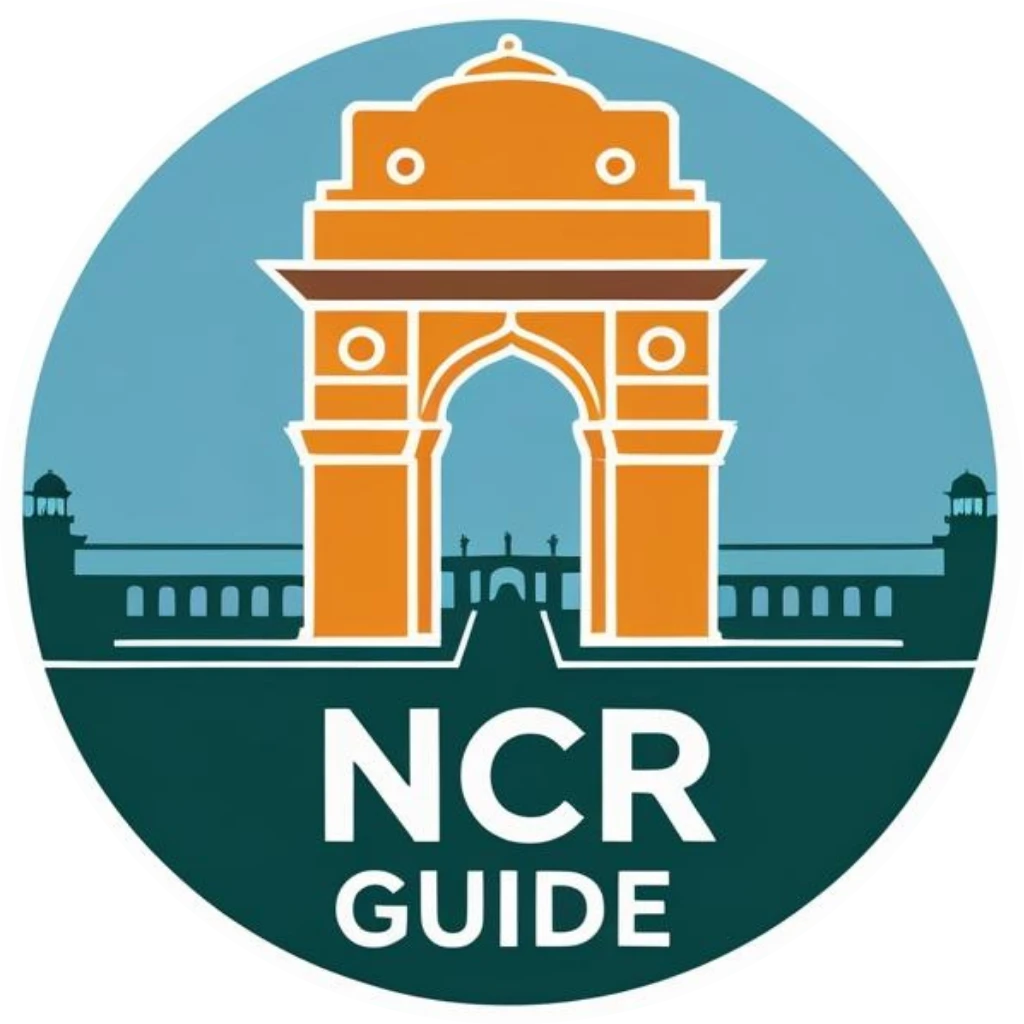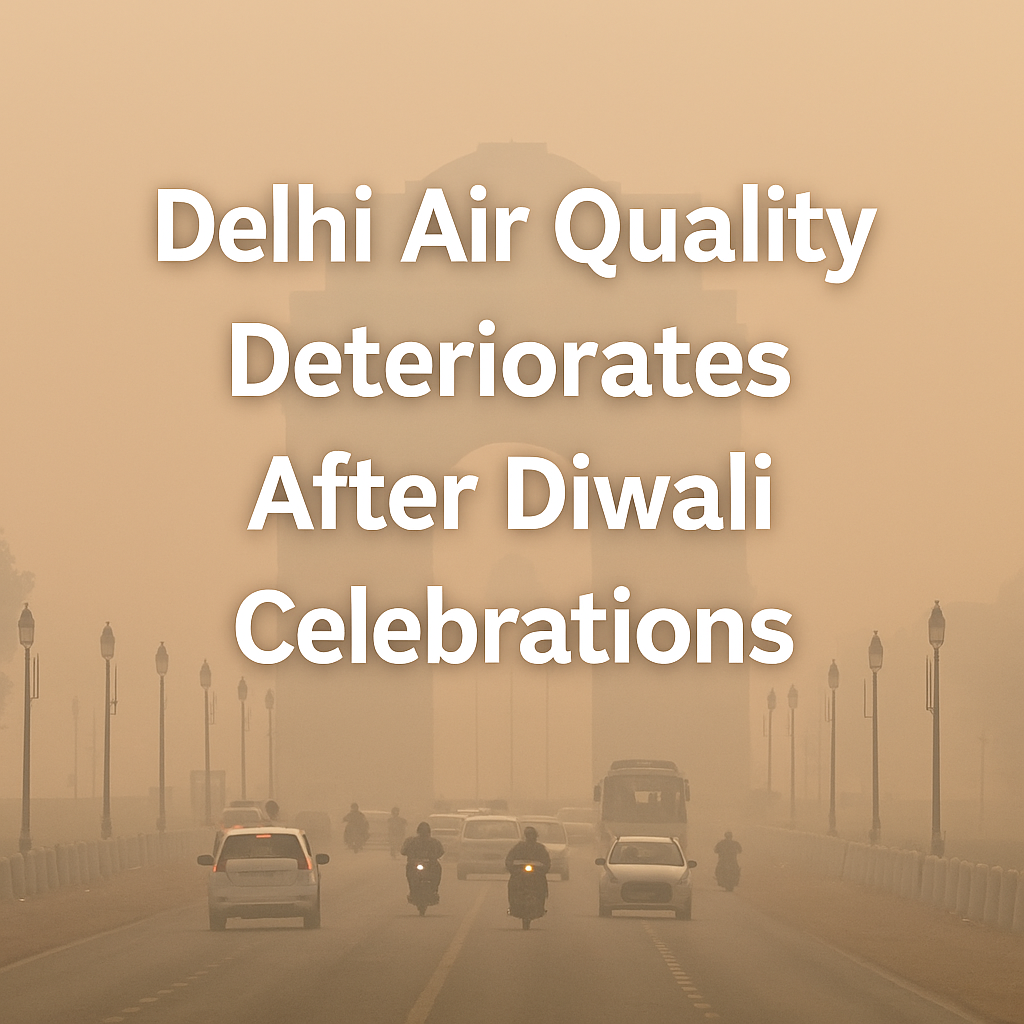Delhi woke up on Monday morning under a thick blanket of haze as air pollution levels soared following Diwali celebrations. Despite strict bans on firecrackers and multiple awareness campaigns, the capital’s air quality slipped into the “very poor” category, reviving concerns over post-festival pollution and public health.
The Morning After Diwali
By early morning, Delhi’s Air Quality Index (AQI) had crossed 330 in several parts of the city, including Anand Vihar, Punjabi Bagh, Jahangirpuri, and RK Puram, according to the Central Pollution Control Board (CPCB).
For reference, AQI between 301 and 400 is classified as “very poor” — meaning the air poses health risks to sensitive groups and can cause respiratory issues even among healthy individuals.
The skyline was veiled in haze, with visibility dropping significantly across major corridors such as Ring Road, India Gate, and the Delhi-Gurugram Expressway. Early commuters reported irritation in eyes and throat, while health officials advised residents, particularly the elderly and children, to stay indoors during morning hours.
“The difference from last night to this morning is stark. The air feels heavy and the smell of smoke lingers everywhere,” said Kavita Mehra, a resident of Lajpat Nagar.
Why Delhi’s Air Quality Deteriorated
Authorities had imposed a complete ban on firecrackers in Delhi this year under the Graded Response Action Plan (GRAP), warning of penalties for violators.
However, enforcement remained a challenge. Several areas witnessed residents bursting fireworks well past midnight. Even so-called “green crackers”, designed to emit fewer pollutants, contributed to dense smoke due to low wind speeds and dry atmospheric conditions.
Environmental scientists explained that calm wind patterns and falling night temperatures trapped pollutants close to the ground. The combination of PM2.5 and PM10 particles — generated by fireworks, vehicles, and stubble burning from neighboring states — created a perfect storm for poor air dispersion.
“Delhi’s pollution spike isn’t just about firecrackers. It’s a combination of festive emissions, stagnant winds, and crop residue burning in Punjab and Haryana,” said Dr. Ajay Nagpal, an air quality researcher with IIT Delhi.
Pollution Levels Compared to Last Year
Data from SAFAR-India showed that pollution levels this Diwali were nearly double compared to 2024.
Last year, the post-Diwali AQI was around 190–220 (moderate to poor range), thanks to light rain and stronger winds. In contrast, 2025 saw stagnant atmospheric conditions and an increase in late-night firework activity despite bans.
Experts say that the situation could worsen over the next 48 hours if wind speed remains below 5 kmph.
What the Government Is Doing
The Delhi government and pollution control boards have begun reviewing emergency measures under GRAP Stage II, which includes:
- Ban on diesel generators and open burning
- Increased frequency of water sprinkling and road cleaning
- Enhanced deployment of anti-smog guns
- Strict checks on construction dust and vehicular emissions
The government has also urged residents to use public transport and avoid outdoor physical activity during peak pollution hours (6 AM to 10 AM and 6 PM to 10 PM).
The Green Crackers Debate
This year’s enforcement drive placed particular emphasis on discouraging the use of “green crackers”, which were initially introduced as an eco-friendlier alternative. However, experts now question their real-world impact.
Green crackers reduce emissions by roughly 25–30%, but still release sulphur dioxide, carbon monoxide, and fine particulate matter that aggravate winter smog.
“There’s no such thing as safe fireworks when wind speeds are this low. Even green variants add to the particulate load,” said Anumita Roychowdhury from the Centre for Science and Environment (CSE).
Health Concerns and Public Warning
Doctors have reported a spike in respiratory distress cases since early morning. Hospitals across Delhi and Noida have seen an increase in patients with breathing difficulties, asthma triggers, and eye irritation.
The Indian Meteorological Department (IMD) predicts that air quality may remain in the “very poor” category for the next two days, with marginal improvement expected by midweek as wind patterns shift.
Health experts are urging residents to:
- Use N95 or N99 masks when stepping outdoors.
- Avoid morning walks or outdoor exercise.
- Keep air purifiers on in enclosed spaces.
- Stay hydrated and seek medical advice for prolonged coughing or irritation.
Citizens React: Between Celebration and Responsibility
While some residents expressed disappointment over the air quality, others defended moderate firecracker use as part of cultural tradition. Social media was flooded with contrasting opinions — from photos of glowing night skies to images of thick morning smog.
“Festivals are meant to bring joy, not headaches and coughing fits,” wrote one user on X (formerly Twitter). Another countered, “We celebrated responsibly with green crackers. Why blame tradition alone for pollution?”
The divide underscores the broader challenge of balancing celebration with sustainability in a city already struggling with chronic air pollution.
A Familiar Pattern Returns
Every Diwali, Delhi’s air quality takes a sharp dip despite repeated warnings. The city’s bowl-shaped geography, combined with weather patterns and human activity, traps pollutants for days.
Environmentalists argue that while firecrackers are a visible contributor, the larger problem is systemic — spanning vehicular emissions, crop burning, industrial smoke, and poor urban planning.
“Unless Delhi treats air pollution as a year-round governance issue, not a post-Diwali crisis, these patterns will continue,” said environmental activist Sunita Narain.
Moving Forward
As the haze thickens, authorities face renewed pressure to implement long-term air quality management, including:
- Stricter regional coordination on stubble burning
- Real-time air quality monitoring at a local scale
- Stronger penalties for pollution law violations
- Citizen participation in community-level awareness programs
Delhi’s fight for clean air, experts say, will require consistency beyond festival bans — it will demand public will and political resolve.
FAQs
Why did Delhi’s air quality worsen after Diwali 2025?
Despite a complete ban on firecrackers, many residents still burst fireworks late into the night. Combined with low wind speed, falling temperatures, and crop residue burning in nearby states, the smoke from crackers got trapped close to the ground. This led to a sharp rise in particulate matter (PM2.5 and PM10), pushing the AQI above 330 — categorized as “very poor.”
What is the current Air Quality Index (AQI) in Delhi?
As of Monday morning, several monitoring stations across Delhi — including Anand Vihar, Punjabi Bagh, and Jahangirpuri — recorded AQI readings between 320 and 360. The citywide average AQI stood around 340, according to data from the Central Pollution Control Board (CPCB).
What are ‘green crackers’ and do they help reduce pollution?
“Green crackers” are modified fireworks developed by the Council of Scientific and Industrial Research (CSIR) that release fewer emissions — roughly 25–30% less particulate matter than traditional crackers. However, in conditions like Delhi’s — where wind speeds are low and humidity is high — even green crackers contribute to dense haze and pollution.
What measures is the Delhi government taking to control pollution?
Authorities have activated Stage II of the Graded Response Action Plan (GRAP), which includes:
- Banning diesel generators and open waste burning.
- Deploying anti-smog guns and water sprinklers on major roads.
- Increasing mechanized street sweeping.
- Tightening checks on construction dust and vehicle emissions.
- Advising citizens to use public transport and avoid outdoor activity during peak hours.
How long will Delhi’s air remain in the “very poor” category?
The IMD and SAFAR forecasts suggest that air quality is likely to remain “very poor” for the next 48 hours, with gradual improvement expected by midweek as wind speeds rise. However, without rain or a strong western disturbance, pollutant levels may remain high throughout the week.
What health precautions should residents take right now?
Doctors recommend the following safety measures:
- Wear N95 or N99 masks outdoors.
- Avoid morning walks or outdoor exercise.
- Use air purifiers indoors.
- Keep windows closed during high pollution hours.
- Drink plenty of water and seek medical advice for persistent cough or wheezing.
Does Delhi’s pollution only spike during Diwali?
No. Diwali acts as a trigger, but the problem is year-round. The city’s chronic pollution comes from vehicles, construction dust, industrial emissions, and seasonal stubble burning. The festive smoke only adds a visible layer to an ongoing environmental crisis.
Why is the pollution problem worse this year compared to 2024?
Last year, Delhi experienced light rain and faster wind movement, which helped disperse pollutants. This year, still air and colder conditions allowed pollutants to accumulate overnight. Data from CPCB shows that post-Diwali AQI in 2025 is nearly double that of 2024.
How can residents contribute to reducing Delhi’s air pollution?
- Avoid firecrackers entirely and encourage others to do the same.
- Use carpooling or public transport instead of private vehicles.
- Report illegal burning or construction dust to local authorities.
- Plant trees and participate in community clean-air drives.
- Support policies focused on renewable energy and waste management.

